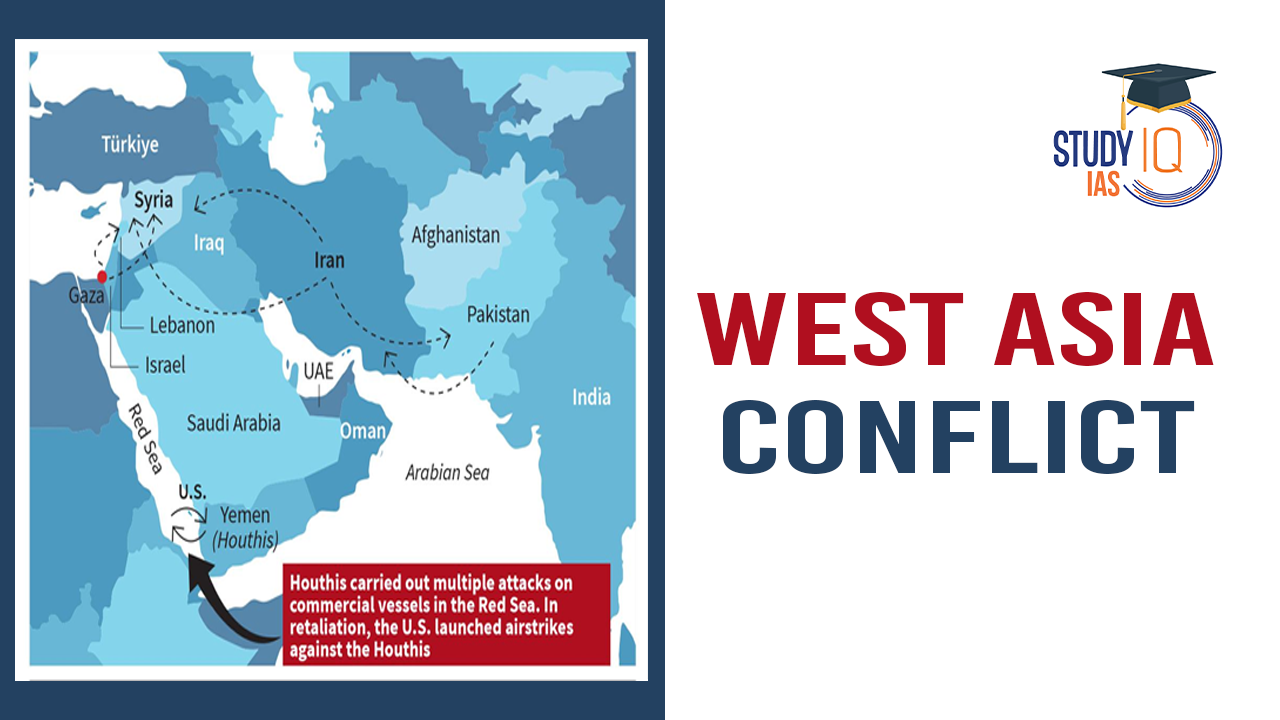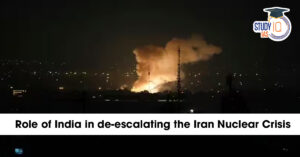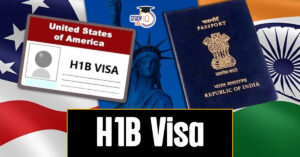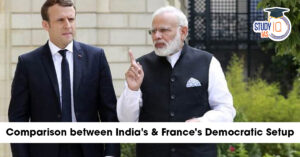Table of Contents
Historical Background of West Asia Conflict
- Post-World War I Developments:
- After World War I and the defeat of the Ottoman Empire, significant changes occurred in the region.
- The victorious Allied powers, mainly Britain and France, divided former Ottoman territories and ignored the wishes of the local Arab population.
- This division led to feelings of betrayal and resentment mostly due to broken promises made to secure Arab support during the war.
- Sykes-Picot Agreement:
- The Sykes-Picot Agreement was a 1916 unofficial treaty between the UK and France, with consent from Russia and Italy, outlining their spheres of influence in the partitioning of the Ottoman Empire.
- It effectively divided Ottoman provinces outside the Arabian Peninsula into areas of British and French control.
- Balfour Declaration:
- In 1917, during World War I, the British government issued the Balfour Declaration, supporting the establishment of a “national home for the Jewish people” in Palestine, which was then an Ottoman region with a small Jewish population.
- This declaration had long-lasting consequences for Arab-Jewish relations in the region.
- Creation of Israel:
- Following World War II, in 1947, the United Nations proposed a partition plan to divide Palestine into separate Jewish and Arab states, with Jerusalem as an international city.
- In 1948, Israel declared its independence, leading to conflict with neighbouring Arab states.
- Arab-Israeli War (1948):
- The declaration of Israel’s independence in 1948 prompted surrounding Arab states to attack.
- By the end of this war, Israel controlled approximately 50% more territory than initially outlined in the UN partition plan.
- The 1979 Revolution:
- The overthrow of the Shah in Iran established a religious state after the 1979 Islamic Revolution.
- Iran’s new regime viewed Israel as an occupier of Palestinian land, with Ayatollah Khomeini labelling Israel as “Little Satan” and the U.S. as “Great Satan”.
- A Shadow War after 1979:
- Relations between Israel and Iran deteriorated significantly post-revolution.
- While direct military confrontation has not occurred, both nations have engaged in proxy conflicts and limited strategic attacks against each other.
- In recent years, Israel has targeted Iranian facilities and scientists to prevent nuclear development.
- Recent Instances:
- Israel has escalated the year-long conflict in West Asia by shifting its military focus from Gaza to Lebanon.
- The new target of Israel’s operations is Hezbollah, a more powerful Iranian-backed proxy.
- This move follows Israel’s apparent conclusion of its military campaign against Hamas in Gaza.
- The escalation includes dramatic explosions involving pagers and walkie-talkies aimed at Hezbollah members.
- Hezbollah’s leader Hassan Nasrallah has been assassinated during the operation.
What are its Implications?
- Food Insecurity: Around 17.6 million people in West Asia face food and nutritional insecurity, exacerbated by ongoing conflicts and economic instability.
- Displacement and Refugees:
- As of 2024, approximately 18.2 million people in West Asia require humanitarian assistance. Among them, 4.5 million are displaced individuals.
- Refugee Populations: The region hosts about 11.9 million refugees and asylum seekers, with Turkey hosting the largest number at 3.7 million.
- Internal Displacement: An estimated 14.2 million people live in displacement within West Asia, with the Syrian civil war contributing significantly to this figure.
- Trade Disruptions: Hezbollah’s ties with Houthi rebels in Yemen, who are responsible for attacks on ships in the Red Sea, increase the risk of trade disruptions.
- Increased Shipping Costs: Disruptions in key shipping routes through the Suez Canal and Red Sea have forced vessels to take longer routes via the Cape of Good Hope, leading to an increase in shipping costs.
West Asia Conflict’s Implications For India
- Disruption of trade routes affected India’s trade with Europe, the US, Africa, and West Asia which amounted to over $400 billion in trade in FY23 (according to Global Trade Research Initiative).
- Increased Shipping Costs: Ships being diverted around the Cape of Good Hope due to the conflict have increased shipping costs by 15-20%, directly impacting India’s export profitability, especially for low-margin industries like textiles, engineering, and garments.
- Decline in Exports: India’s petroleum exports dropped 38% in August 2024 due to rising freight costs and shrinking margins, a direct consequence of the conflict and shipping route disruption.
- Overall exports also fell by 9% in the same period, hurting the Indian economy.
- Impacts on Labour-Intensive Industries: Indian exports of low-end engineering products, textiles, and other labour-intensive goods face profitability issues due to higher shipping rates, which could lead to job losses and a slowdown in these sectors.
- Economic Corridor at Risk: The conflict threatens to derail the recently launched India-Middle East-Europe Economic Corridor (IMEC).
- If the instability persists, this major infrastructure and trade project, intended to boost connectivity and economic cooperation, could face significant delays or derailment, affecting India’s broader economic strategy in the region.
Proposals to Address the West Asia Conflict
- Negotiations and Two-State Solution
- Two-State Solution Advocacy: Many international actors, including the United Nations and the Arab League, advocate for a negotiated two-state solution where Israel and Palestine coexist as independent states.
- Oslo Accords: Previous negotiations between Israel and the Palestine Liberation Organization (PLO) aimed to establish this framework but have only yielded temporary halts to conflicts.
- The U.S. has proposed various peace plans, including one under former President Trump that recognized Israeli settlements on occupied territories in exchange for a freeze on new settlement activity during negotiations.
- Ceasefire and Humanitarian Assistance
- Immediate Ceasefires: Calls for immediate ceasefire agreements to halt hostilities and allow humanitarian assistance to reach affected populations.
- Brokered Ceasefires: Temporary ceasefires have been brokered by regional actors such as Egypt and Qatar during periods of intense conflict.
- Humanitarian Aid: International organisations provide critical aid to those affected by the conflict, particularly in Gaza and the West Bank.
- International Mediation
- Neutral Mediators: Involvement of neutral international mediators, such as the United Nations, to facilitate negotiations and peace talks.
- Peace Conferences: Russia proposed a West Asia Peace Conference to focus on a two-state solution, emphasising the need for credible engagement with both Palestinians and Israelis.
- Addressing Core Issues
- Root Causes: Efforts to address fundamental issues such as land disputes, resource access, and refugee rights are essential for long-term stability.
- Human Rights Compliance: Ensuring both parties respect international humanitarian law and human rights standards, with accountability for violations through mechanisms like ICC investigations.
- People-to-People Initiatives: Initiatives like Seeds of Peace and OneVoice promote cooperation through joint business, educational, and cultural projects.
- Regional Cooperation: Arab Peace Initiative offers normalisation of relations between Israel and Arab states in exchange for a comprehensive peace agreement with Palestinians.
- Economic Development Initiatives: Organise conferences to raise funds for infrastructure projects in the West Bank and Gaza.


 Iran Nuclear Crisis and India’s Role f...
Iran Nuclear Crisis and India’s Role f...
 H1B Visa Program, Beneficiaries, Eligibi...
H1B Visa Program, Beneficiaries, Eligibi...
 Comparison Between India & France's ...
Comparison Between India & France's ...

























